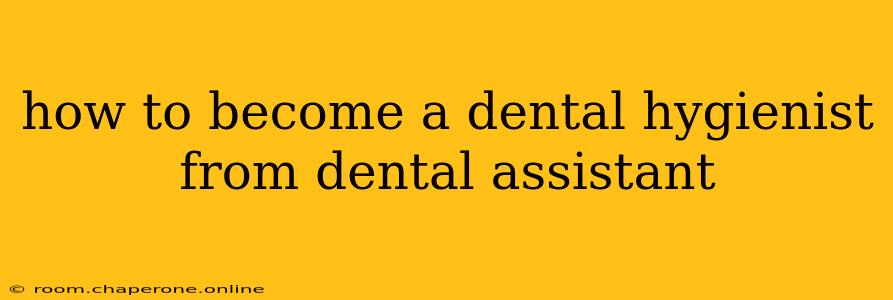Many dental assistants find themselves drawn to the more advanced role of a dental hygienist. It's a natural progression—you're already familiar with the dental environment, the procedures, and the team dynamic. But the path from dental assistant to dental hygienist requires dedication, education, and strategic planning. This comprehensive guide outlines the steps you need to take to make this career transition successfully.
Understanding the Differences: Dental Assistant vs. Dental Hygienist
Before diving into the transition process, it's crucial to understand the key differences between these two roles. Dental assistants primarily focus on assisting dentists during procedures, sterilizing instruments, taking X-rays, and providing patient care. Dental hygienists, on the other hand, provide preventative care, including:
- Cleaning teeth: Removing plaque and tartar buildup.
- Applying fluoride: Strengthening tooth enamel and preventing cavities.
- Educating patients: Providing instruction on oral hygiene practices.
- Taking X-rays: To detect dental problems.
- Performing oral cancer screenings: Identifying potential issues early.
While some tasks overlap, the scope of practice for a hygienist is significantly broader and requires specialized education and licensure.
Steps to Become a Dental Hygienist from a Dental Assistant
The journey from dental assistant to dental hygienist primarily involves obtaining the necessary education and licensure. Here's a detailed breakdown:
1. Assess Your Current Qualifications and Prerequisites
Start by evaluating your existing credentials. Depending on your location and the specific requirements of your chosen program, you might need certain prerequisites. This could include:
- High school diploma or equivalent (GED): This is typically the minimum requirement.
- Specific coursework: Some programs might require completion of specific science courses (e.g., biology, chemistry) before applying.
- Dental assisting certification: Your experience as a certified dental assistant will be a considerable advantage, demonstrating your foundational knowledge. Highlight this in your application!
2. Research and Choose an Accredited Dental Hygiene Program
The next crucial step is finding an accredited dental hygiene program. Accreditation ensures the program meets specific standards of quality and prepares graduates for licensure. Research programs in your area, comparing factors like:
- Accreditation: Verify the program's accreditation through recognized bodies like the Commission on Dental Accreditation (CODA) in the United States.
- Program length: Programs typically last two to four years, depending on whether you enter as a direct-entry or transfer student.
- Curriculum: Look for programs that offer a comprehensive curriculum covering all aspects of dental hygiene.
- Clinical experience: Hands-on experience is vital. Choose a program with extensive clinical rotations in diverse settings.
- Cost and financial aid: Consider the overall cost of the program and explore available financial aid options, including scholarships and loans.
3. Apply to and Complete the Dental Hygiene Program
Once you've identified suitable programs, carefully follow the application procedures. This usually involves:
- Submitting transcripts: Provide official transcripts from your high school and any previous college coursework.
- Providing references: Secure letters of recommendation from individuals who can attest to your abilities and character.
- Taking entrance exams: Some programs may require standardized tests, like the TEAS (Test of Essential Academic Skills).
- Attending interviews: Be prepared to discuss your career goals and demonstrate your passion for dental hygiene.
The program will involve a rigorous curriculum encompassing both classroom learning and extensive hands-on clinical experience. Maintain a high GPA to enhance your chances of success and future job prospects.
4. Pass the National Board Dental Hygiene Examination (NBDHE)
After successfully completing your program, you'll need to pass the NBDHE. This is a nationally standardized examination that tests your knowledge and skills. Thorough preparation is essential. Many programs offer comprehensive review courses to aid in this process.
5. Obtain Your State Licensure
Finally, you'll need to obtain your state dental hygiene license. The specific requirements vary by state, but generally involve:
- Passing the NBDHE: As mentioned above.
- Passing a state-specific clinical exam: This assesses your practical skills.
- Background check: A thorough background check is commonly required.
- Application and fees: Submit a complete application and pay associated fees to your state's licensing board.
Leveraging Your Dental Assisting Experience
Your experience as a dental assistant provides a significant advantage. You can:
- Highlight your practical skills: Emphasize your existing skills and experience in your application materials.
- Network within your current practice: Talk to your dentist and colleagues about your career aspirations. They might offer support and mentorship.
- Seek mentorship: Find a seasoned dental hygienist who can provide guidance and support throughout the transition.
Becoming a dental hygienist from a dental assistant is achievable with dedication and careful planning. By following these steps, you can successfully transition to this rewarding and in-demand career. Remember to research thoroughly, plan meticulously, and embrace the challenges with perseverance. The professional and personal rewards will be well worth the effort.

